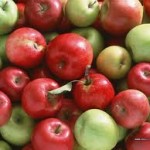The Whole Apple, Or The Juice?
 Juice has been pressed, as has wine, since before the middle ages. Look at what I found out about some common fruits and vegetables;
Juice has been pressed, as has wine, since before the middle ages. Look at what I found out about some common fruits and vegetables;
- Apples reduce cholesterol.
- Carrots have a high beta carotene content making them great for skin, brain, fighting cancer, protecting arteries, fighting infections and boosting the immune system. Carrots also help to eliminate putrefactive bacteria in the colon and help eliminate intestinal parasites.
- Cucumber cleanses the kidneys.
- Celery helps with weight loss, reduces bloating, and is a powerful diuretic.
- Berries contain antioxidants which can prevent cell damage to your eyes.
- Pineapples aid in digestion and can help dissolve a blood clot.
- Papaya also aids in digestion and protects against cancer.
- Tomatoes are known to lower your risk of cancer, and are good for the heart due to its high amount of lycopene.
- Cabbage can heal stomach ulcers, and also fights cancer.
- Dandelion greens has the leafy green benefits of chlorophyll, and is is specifically good for cleaning out the kidney, liver, gallbladder, bowel and pancreas.
- Citrus fruits contain carotenoids, bioflavonoids and tons of vitamin C which help to fight cancer. They also lower blood pressure and help to reduce plaque from arteries, are antiviral, and antibacterial.
And the list goes on and on and on. But why do we want to juice these fruits and vegetables, and  not just eat them? Because, when you drink freshly pressed fruits and vegetables, highly concentrated vitamins, minerals and enzymes rapidly enter the bloodstream, and you would have to eat 2 pounds of carrots, 12 apples, half of a pineapple, and 1 entire cabbage to equal 16 ounces of juice, so with juicing you get a huge amount of vitamins and enzymes in just one glass, and will probably fulfill your 8 servings of fruits and vegetables in the one juice serving. Absorption is immediate, bypassing digestion, and drinking juice also gives your digestive tract a little rest.
not just eat them? Because, when you drink freshly pressed fruits and vegetables, highly concentrated vitamins, minerals and enzymes rapidly enter the bloodstream, and you would have to eat 2 pounds of carrots, 12 apples, half of a pineapple, and 1 entire cabbage to equal 16 ounces of juice, so with juicing you get a huge amount of vitamins and enzymes in just one glass, and will probably fulfill your 8 servings of fruits and vegetables in the one juice serving. Absorption is immediate, bypassing digestion, and drinking juice also gives your digestive tract a little rest.
Juicing is being used to cure dementia and Alzheimers, and for cancer cures and prevention, as well as a array of other diseases. Let me emphasize that juicing to cure disease is a total life style, and may require making juice up to a dozen times a day, and is not for everyone.
And here is some interesting trivia on the color of your foods; The color of your food, as well as the color of the dishes you eat from, your table linens, and even the color of the walls in the room you eat in, all can have an affect on your appetite. Depending on the colors, your senses may be excited and entice you to eat more, while other colors might actually suppress the appetite. Here is how colors affect our appetites:
red-energy and enthusiasm
yellow- memorable and exciting
green- healthy- eat without risk
white- causes overeating and mindless snacking
blue- suppresses appetite
black- eat with risk




